The Quebec Nordiques almost didn’t exist. And depending on who you ask, maybe they shouldn’t have existed at all.
In fact, their story begins on the other side of the continent, under the considerably warmer skies of San Francisco, California.
Sign up for our NHL History Substack newsletter
The Nordiques (roughly translated as the “Northerners” or “Northmen”) were originally called the San Francisco Sea Hawks, under the ownership of Gary Davidson, the lawyer and businessman who co-founded and served as president of the World Hockey Association. However, in February of 1972, even the NHL was having issues winning over fans in the Bay Area with the Golden State Seals. At the last minute, Davidson’s team was purchased by a Quebec-based group of businessmen – Paul Racine, Jean Dacres, and Jean Lesage – who moved the franchise to the city of Quebec; a city that had been clamoring for a professional hockey team since the old Bulldogs of the NHL in 1920.
Related: The WHA – A Look Back at the Upstart Hockey League
If it wasn’t for these investors and the fortuitous lack of funding for the San Francisco team, there’s a good chance Quebec wouldn’t have sniffed a professional hockey team for a long time. Funding, or lack thereof, was a stigma that followed the Quebec Nordiques long after they were gone.
The Quebec Nordiques Early Days
Aside from their blue and white sweaters with the iconic red igloo logo in the middle, nobody knew what the Nordiques would actually look like in their first season in the WHA in 1972-73. While they literally weren’t in the same league as the Montreal Canadiens, Quebec City’s provincial big brother in the NHL, the goal initially was to model themselves after the Habs.
The Nordiques signed mostly French-Canadian players from the juniors, in order to fit in better with the French culture of the city. They managed to sign Montreal Canadiens superstar J.C. Tremblay for a little bit of on-ice credibility and hired NHL legend Maurice “The Rocket” Richard (a man who knew a thing or two about playing professional hockey) as the first head coach in franchise history.
Richard, for all his experience in the NHL, had never coached a team before, but the name alone was bound to invite intrigue. “I’ve never done this thing before,” he told the Montreal Gazette before the season began. (from ‘Rocket Returns—as Quebec WHA Pilot,’ Montreal Gazette, 07/28/1972) “I don’t know how long I’ll last.” As it turned out, not very long. “The Rocket” coached only two games before realizing that the gig wasn’t for him, mostly due to the severe nervous strain it put upon him. Head scout Maurice Filion replaced him, and he coached the team to a dismal 30-40-5 record in their inaugural season.
As the years went on, the club improved. By the 1974-75 season, under the head coaching of Jean-Guy Gendron, the Nordiques captured first place in the Canadian Division, thanks in part to a stellar offense led by former Los Angeles King Serge Bernier (54 goals, 122 points). Although that season ended with a loss in the AVCO Cup Finals to the Houston Aeros, the Nordiques continued to become an offensive powerhouse.
Under yet another new head coach, Marc Boileau, the team returned to the Final two seasons later in 1976-77. This particular squad included outstanding performances from players like Real Cloutier (66 goals, 141 points), Marc Tardif (49 goals), Chris Bordeleau (107 pts), Paulin Bordeleau (42 goals), and Bernier (43 goals), all of whom played key roles in defeating the Winnipeg Jets in seven games to win the club’s first and only professional championship.
A Rivalry Born From Beer
Between 1977-79, discussions began in earnest to merge the NHL and WHA, and the Nordiques were one of the main teams involved. Based on their success, they were obviously one of the strongest and most supported teams in the league, so it would make sense for NHL expansion to include the Nordiques.
However, Sam Pollock, the highly successful general manager of the Montreal Canadiens at the time, wasn’t too keen on the idea of bringing the Nordiques into the NHL. As Jean Beliveau explained in his book My Life in Hockey, the province of Quebec was “exclusive Montreal Canadiens territory.” Up to that point, the Canadiens were the cream of the crop in Quebec (and the rest of the NHL for that matter), and the last thing Pollock wanted was to share the revenue. A little competition was not what he had in mind.
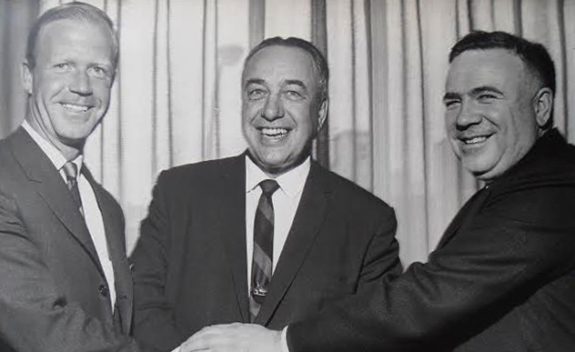
But that wasn’t the only issue. In 1976, the O’Keefe Brewing Company became the majority shareholders of the Quebec Nordiques, ensuring the team a strong financial backing, especially for improvements that would have to be made to the low capacity Le Colisée, the Nordiques’ home arena.
While this was good for Quebec City’s NHL bid, the Canadiens were not happy, because they happened to be owned by the O’Keefe’s rival, Molson Breweries. The last thing they wanted was another beer stomping on their turf. So, the Canadiens opposed the Nordiques’ entrance into the NHL, denying them the bid.
The Nordiques considered the Canadiens’ petty veto as a direct insult, and in turn, an anti-Canadiens sentiment spread from the province to the rest of Canada. Molson products were threatened to be boycotted by fans all across Canada in solidarity with the Nordiques. Fans in Edmonton and Winnipeg, whose teams were also entering the NHL from the WHA, planned a beer strike against Molson Breweries because of the veto.
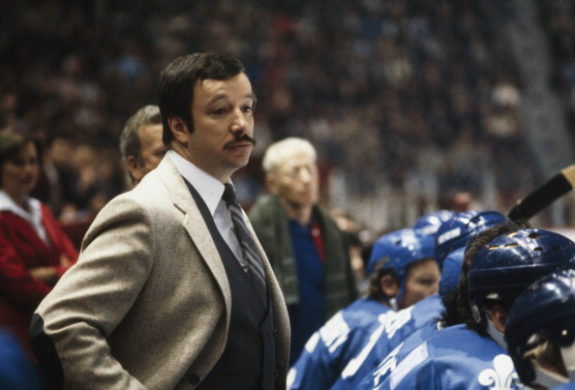
For Molson, it was a public relations nightmare, and it didn’t take long before the Canadiens were forced to change their vote to “yes.” Thus, for the 1979-80 season, a new NHL franchise and rivalry was born. After the ordeal, beer wasn’t the only thing leaving a bad taste in the mouths of the two clubs. It was only a matter of time before things became really ugly between these provincial neighbours.
The Good Friday Massacre
On April 20, 1984, in Montreal, the Nordiques and Canadiens faced off in what became one of the greatest games in NHL history. It was also one of the ugliest. Their rivalry reached a breaking point, and while it had implications for the NHL (it was a playoff game after all), it also encapsulated to the political and social landscape in Canada at the time.
In the 1970s, politician René Lévesque founded the Parti Québécois (a.k.a. Péquistes), a political party whose main objective was Quebec sovereignty. Basically, Quebec wanted out but Canada wouldn’t let it happen. After heated campaigns, rejected proposals, and some persuading from Prime Minister Pierre Trudeau, Canada narrowly managed to survive the referendum for separation. By the spring of 1984, the political events left Canada reeling and the Québécois feeling betrayed.
In a 1945 essay, George Orwell wrote about the obsession of sport, and how nationalism and sport together can be a dangerous and fierce concoction. Teams become representatives of whole nationalities. “You do make things worse by sending forth a team of men to do battle against some rival team,” Orwell writes. “And allowing it to be felt on all sides that whichever nation is defeated will ‘lose face’.”
In this particular case, the Canadiens and Nordiques represented more than just sports. As the NHL’s most storied franchise, the Canadiens stood for the nation of Canada (and the non-separatists of the province), while the Nordiques embodied the Separatist Movement that was boiling throughout the province.
From a purely NHL standpoint, these teams were two of the best in the league at the time. The talented Nordiques squad of 1984 was a favorite to win the Stanley Cup, thanks to superstar performances from players like Michel Goulet (56 G, 65 A, 121 P) and Peter Stastny (46 G, 73 A, 119 P). The Canadiens on the other hand, while not quite the powerhouse it was in the 70s, were ready to make a Cup run of their own. The Nordiques were expected by many to steamroll the Canadiens.
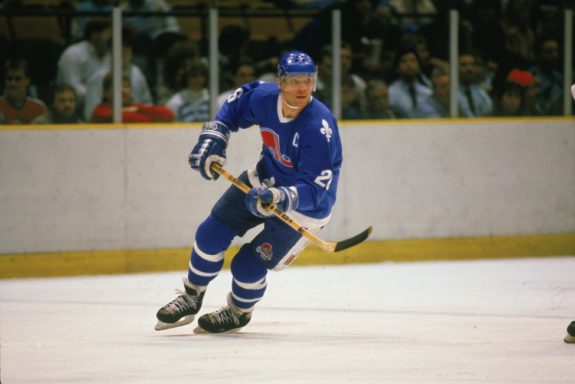
“The thing was we beat them so handily all year long,” said Nordiques winger Tony McKegney. “We beat them seven out of eight games that year. One game we beat them 7–1 in Montreal. We had their number all season.” Despite the teams’ record against each other, the Habs grabbed a surprising 3-2 series lead, only needing a crucial Game 6 at the Forum to complete the upset.
Needless to say, tensions at the start of Game 6 were high. “Knowing the rivalry and everything that was built up—the year before we beat them in the playoffs—every game for us against Montreal was like a Stanley Cup game,” said Nordiques winger Louis Sleigher.
Just 23 seconds into the game, Canadiens’ Mike McPhee and Nordiques’ Wilf Paiement got into a scrap. The animosity was simmering to a boil. By the end of the second period, the Canadiens found themselves in a 1-0 hole, as the Nordiques broke the ice on a goal by Stastny. The Habs were looking for a way to get back into the game, and when the puck isn’t bouncing your way, something else needs to be done. A message had to be sent.
Dale Hunter, the Nordiques’ tough guy, had been going after rookie Canadiens goaltender Steve Penney all night. He was one of those players who could get under an opponent’s skin very quickly, relishing in his role as the villain. As the siren at the Forum rang, signaling the end of the second period, Hunter pinned Canadiens forward Guy Carbonneau to the ice in front of Nordiques goaltender Dan Bouchard. This prompted Canadiens Chris Nilan to respond by jumping on Hunter. Then all hell broke loose…
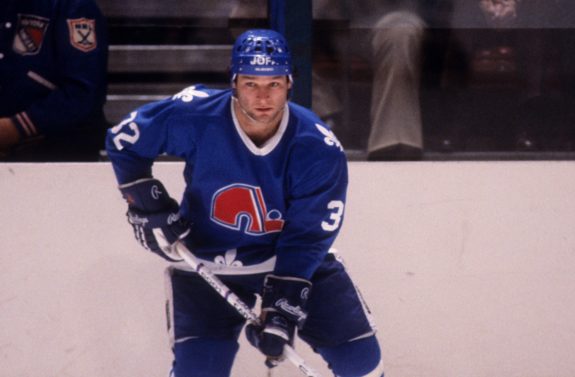
To this day, the “Good Friday Massacre,” as it was dubbed, remains one of (if not THE) nastiest brawls in NHL history. Thirty-three years later, the video of the whole thing is still hard to watch. As Orwell put it in his essay, it was an explosion of the vast ill-will between nationalities colliding with the already fierce passions of the athletes. It was a chaotic struggle of wills, the likes of which the NHL may never see again.
After the smoke had cleared, the referees were left to sort out the penalties among the debris of gloves, sticks, helmets, and blood. Eleven players were tossed, 252 penalty minutes were handed out, and there were at least 14 fights recorded, including one in which Sleigher sucker-punched Jean Hamel, knocking him out cold (oh, and by the way, despite all this, Sleigher was allowed back on the ice for the third period!).
By some divine act of redemption from the hockey gods, and despite even more fights in the third period, the Montreal Canadiens won the game 5-3, proving that living well is the best revenge. The Habs may have been bruised, but they were moving on while the Nordiques had to clean out their lockers.
Speaking of which, while the Nordiques were clearing out, they earned some rock and roll cred, as told by McKegney:
“Everybody in Quebec was watching the game. Van Halen was in Quebec City, playing a concert in our arena the following day. So these guys were at the bars, and the game was on every TV, so they’re watching it going, “Holy Christ, what’s going on here?” They weren’t really into hockey and just couldn’t believe it.
So as we’re clearing out our lockers, having an end-of-the-year beer and pizza, hanging around, they’re setting up for a soundcheck. It was the 1984 ‘Jump’ tour. So we’re down in the same area as them, they’re using three or four locker rooms for the band and the crew. Nice guys. They were just mesmerized from what they saw the night before with the brawl. They’d never seen anything like it. They’re sitting around with the road crew as this game heightened and it drew everybody to it. I remember them asking us, “How do you guys do this? Is this what you do every game?” We’re sitting there with black eyes. They thought we were crazy.”
Sleigher wasn’t quite as amused,
“Yes, Van Halen was there. That was our big moment, I suppose. I would have preferred to beat Montreal, though.”
Building Someone Else’s Stanley Cup
As the years went on and the decade changed, the Quebec Nordiques tumbled around the bottom of the NHL. From 1989-91, the Nordiques won only 26 games in TOTAL. They practically wrote the book on tanking, albeit maybe not on purpose. Either way, through a few fortuitous draft picks, the team began racking up future NHL superstars like Joe Sakic, Mats Sundin, and Owen Nolan. In their early careers, Sakic and Sundin led the team in scoring.
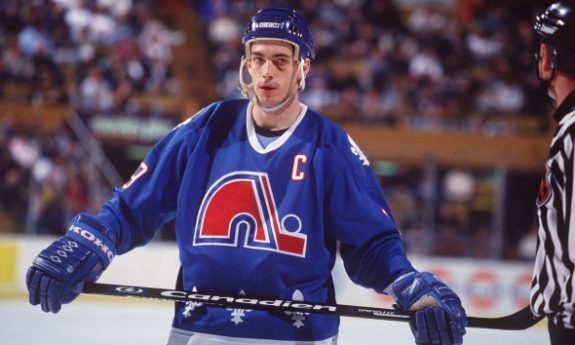
In 1992, the Nordiques used their third consecutive first overall pick on a player named Eric Lindros. Lindros, a uniquely hard-hitting and highly skilled center, was thought to be a generational player in the mold of Gretzky and Lemieux. He was a freak of nature whose size belied his offensive talent. Thanks to their futility, they had the chance to land yet another franchise player to bring them out of the doldrums. However, Lindros had other ideas.
Whether it was his parents, Quebec City’s poor market, rumors of team relocation, or (as Lindros put it recently) the Nordiques ownership at the time, the future Hall of Famer refused to play for Quebec. He didn’t even put on their jersey on draft day. In an unprecedented move at the time, Lindros held out from the Nordiques and the NHL, and the Nordiques had no choice but to trade him in what turned out to be one of the biggest and most influential trades in NHL history.
The Nordiques worked out a deal with both the New York Rangers and the Philadelphia Flyers. The teams needed an arbitrator to settle the issue, and eventually, it was decided that Lindros would be headed to the City of Brotherly Love. In exchange for the rights to Lindros, the Nordiques received the following assets from the Flyers: Peter Forsberg, Steve Duchesne, Kerry Huffman, Mike Ricci, Ron Hextall, Chris Simon and first-round picks in 1993 and 1994. This was one hell of a return for a guy that hadn’t even played a minute in the NHL, but hype is a funny thing. Luckily for the Flyers, the trade worked out just fine as Lindros had a stellar career playing for the orange and black, although he never won a Stanley Cup.
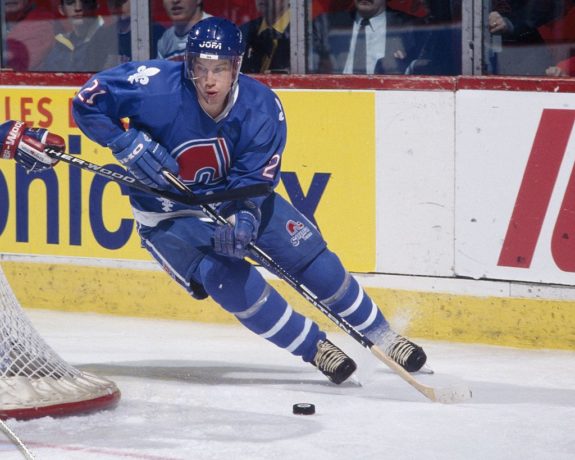
As for the Quebec Nordiques, they were quickly working their way towards legitimate Stanley Cup contention for the first time since “The Brawl,” thanks to the trickling effects of the trade. In 1993, using one of the first-round picks from the Lindros deal, the Nordiques selected goalie Jocelyn Thibault. (Thibault would later be one of the pieces sent to Montreal for Hall of Fame goalie Patrick Roy.) The Nordiques eventually used their other first-round pick to select Adam Deadmarsh, another future asset for the franchise.
The team the Nordiques were waiting for was finally coming together. All seemed well in Quebec City again, but lurking behind was an inevitable wind of change the team couldn’t avoid.
In the lockout-shortened 1995 season, the Nordiques finished first in the Eastern Conference. They were true Cup contenders once again, but they were bounced out of the playoffs early by the defending champion New York Rangers. Unbeknownst to the fans at the time, it was the team’s swan song.
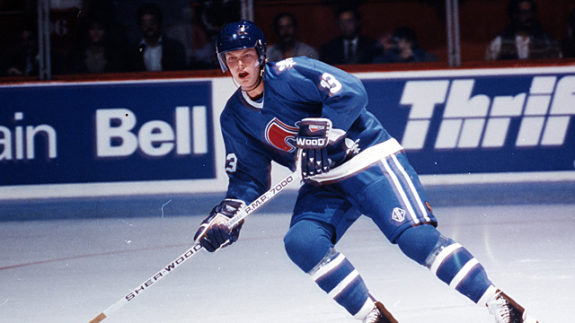
It’s never easy to see a team go and move on from a city like a wandering nomad. Nordiques owner Marcel Aubut never wanted to leave, but there were factors beyond his control that would leave his hands tied. (from ‘Twenty years later, former Nordiques owner Aubut mulls NHL’s possible return to Quebec,’ Montreal Gazette, 06/25/2015) For starters, Quebec City was the smallest market in the NHL at the time and the second-smallest city in the province. Le Colisée arena was too small, and it was becoming antiquated. It needed a lot of renovation, but that would require money that the team didn’t have.
Without any sort of cap in place, players’ salaries were skyrocketing, while the Canadian dollar was failing. Nordique ownership began to prepare for the worst. There’s no question the team had some of the most passionate fans in the league, but the NHL is a business and a diminishing bottom line couldn’t be ignored. Aubut had no choice but to sell the franchise to a group of investors in Denver, Colorado for a cool $103 million, and just like that, the Quebec Nordiques were no more.
Instead, they became the Colorado Avalanche, and in a cruel twist of fate, that team, with all the Nordiques players, after years of heartbreak and agony in Quebec, won the Stanley Cup in their inaugural season. Just over a decade after the “Good Friday Massacre,” Nordiques fans ended up receiving the sucker punch.
Will the Quebec Nordiques Return to the NHL?
It’s an interesting question that doesn’t have a clear-cut answer. It’s no secret that NHL Commissioner Gary Bettman wants to continue to expand the NHL, and while Quebec City has been ready for the last 20+ years, Bettman has had his eyes set elsewhere. As mentioned earlier, the NHL is a business, where owners and shareholders are favored over the needs of the fans.
Related: 7 Cities That Make Sense for NHL Relocation
In 2017, NHL expansion saw Vegas added to the roster, and before that, Winnipeg got their team back, and Seattle readies itself to join the NHL ranks in 2021. Of course, Quebec City is always in the running for the next franchise, but unfortunately, Bettman still has to view it from a financial standpoint, and relatively speaking, neither the Canadian dollar nor the Quebec market has strengthened since the 1990s. For these two reasons alone (and the fact that Bettman hates Canada…just kidding…maybe), the NHL remains hesitant to return to Quebec City.
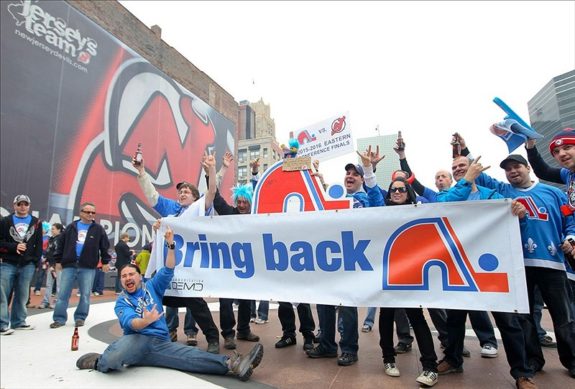
Quebec City does have a shiny new 18,000-seat arena called the Centre Vidéotron ready to go at a moment’s notice, with a built-in fan base that has been anxiously waiting 20 years for the NHL’s return. It couldn’t be any worse than putting ice hockey in the middle of the desert, right?
It’s fair to say that it seems like a matter of time until the NHL makes a return to the City of Quebec. Of course, they’ll just need some financial backing. Perhaps Labatts would want to invest in a new rivalry?
